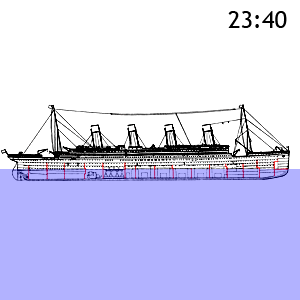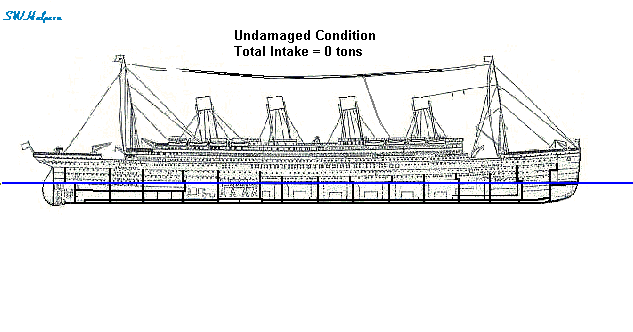- Reaction score
- 1
- Points
- 430
Yep,
I love good treasure hunts, and the Titanic was a massive find. This seems like a history changer, if true!
http://startouch.thestar.com/screens/fb89aab2-c004-48fa-917d-295df66d39ae%7C_0.html
Before the iceberg, a fire may have doomed the Titanic
A new documentary theorizes a coal blaze weakened the hull during construction
Dan Bilefsy The New York Times
LONDON — Maybe it wasn’t just the iceberg.
Ever since the Titanic sank on April 15, 1912, killing more than 1,500 men, women and children, mystery has swirled around the tragedy. No one doubts that the ship collided at high speed with an iceberg off the coast of Newfoundland.
But a new documentary posits that the demise of the ship, hailed at the time as the largest ever built, and praised for its professed unsinkability, may have been accelerated by a giant coal fire in its hull that occurred weeks before it set off on its fateful journey to New York from Southampton, England.
In the documentary, broadcast on Channel 4 in Britain on New Year’s Day, Senan Molony, an Irish journalist who has spent more than 30 years researching the Titanic, contends that the fire, in a three-storey-high bunker next to one of the ship’s boiler rooms, damaged its hull, helping to seal its fate long before it slammed into the iceberg.
“It’s a perfect storm of extraordinary factors coming together: fire, ice and criminal negligence,” he argues in the documentary, Titanic: The New Evidence.
“The fire was known about, but it was played down. She should never have been put to sea.”
Molony’s potential breakthrough can be traced to an attic in Wiltshire, in southwest England, where a previously unpublished album of photographs chronicling the ship’s construction and the preparations for its maiden voyage had been gathering dust for more than a century.
The photos were discovered by a descendant of a director of the Belfast-based company, Harland and Wolff, which built the Titanic.
About four years ago, a collaborator of Molony’s acquired the rare pictures of the ship, meticulously taken by Harland and Wolff’s engineering chief before it left a Belfast shipyard.
When the two men looked closely at the images, Molony said, they were shocked to discover a 30-foot-long diagonal black mark on the hull’s front starboard side, close to where the ship was pierced by the iceberg.
An analysis by engineers at Imperial College London subsequently revealed that the mark was most likely caused by a fire in a coal bunker of the ship.
Molony called the photographs “the Titanic equivalent of Tutankhamen’s tomb,” because of the richness of historical detail they conveyed, including the mark highlighting the extent of the damage.
Experts said the theory was compelling, but were divided over how important a role the fire may have played.
In an interview, Richard de Kerbrech, a marine engineer based on the Isle of Wight who has written two books on the Titanic disaster, said that the fire would have damaged the ship’s bulkhead, a wall of steel within the ship’s hull, and made it more vulnerable after it was pierced by an iceberg.
An official British inquiry, in 1912, mentioned the fire, but the judge who presided over it, whom critics saw as sympathetic to shipping interests, played it down.
“This discovery is a revelation and could change our knowledge of the history of what happened,” de Kerbrech said.
Molony contends that the ship’s owners knew about the fire but chose to let it go, since delaying the ship’s journey would have been financially ruinous.
At the time of departure, the ship was berthed so that the marks caused by the fire were facing the sea, away from the dock, and therefore concealed from passengers.
Molony said he believed the fire had been played down, in part because death by iceberg was a more dramatic explanation.
“The ship was seen as a heroic unsinkable ship and, as a result, people focused on explanations that fed that narrative,” he said.
Not everyone is convinced.
David Hill, a former honorary secretary of the British Titanic Society, who has been studying the cause of the sinking since the 1950s, argued that, while the damage caused by the fire to the steel walls protecting the ship’s hull may have hastened its demise, the blaze was not the decisive factor.
“When the Titanic hit the iceberg close to midnight on April 14, 1912, it created a 300-foot-long line of damage on the starboard section of the hull, including punctures and gashes, that opened up too many compartments to the sea, so that the weight of the water dragged the bow down so low that the ship eventually sank,” he said. “A fire may have accelerated this.
“But in my view, the Titanic would have sunk anyways.”
I love good treasure hunts, and the Titanic was a massive find. This seems like a history changer, if true!
http://startouch.thestar.com/screens/fb89aab2-c004-48fa-917d-295df66d39ae%7C_0.html
Before the iceberg, a fire may have doomed the Titanic
A new documentary theorizes a coal blaze weakened the hull during construction
Dan Bilefsy The New York Times
LONDON — Maybe it wasn’t just the iceberg.
Ever since the Titanic sank on April 15, 1912, killing more than 1,500 men, women and children, mystery has swirled around the tragedy. No one doubts that the ship collided at high speed with an iceberg off the coast of Newfoundland.
But a new documentary posits that the demise of the ship, hailed at the time as the largest ever built, and praised for its professed unsinkability, may have been accelerated by a giant coal fire in its hull that occurred weeks before it set off on its fateful journey to New York from Southampton, England.
In the documentary, broadcast on Channel 4 in Britain on New Year’s Day, Senan Molony, an Irish journalist who has spent more than 30 years researching the Titanic, contends that the fire, in a three-storey-high bunker next to one of the ship’s boiler rooms, damaged its hull, helping to seal its fate long before it slammed into the iceberg.
“It’s a perfect storm of extraordinary factors coming together: fire, ice and criminal negligence,” he argues in the documentary, Titanic: The New Evidence.
“The fire was known about, but it was played down. She should never have been put to sea.”
Molony’s potential breakthrough can be traced to an attic in Wiltshire, in southwest England, where a previously unpublished album of photographs chronicling the ship’s construction and the preparations for its maiden voyage had been gathering dust for more than a century.
The photos were discovered by a descendant of a director of the Belfast-based company, Harland and Wolff, which built the Titanic.
About four years ago, a collaborator of Molony’s acquired the rare pictures of the ship, meticulously taken by Harland and Wolff’s engineering chief before it left a Belfast shipyard.
When the two men looked closely at the images, Molony said, they were shocked to discover a 30-foot-long diagonal black mark on the hull’s front starboard side, close to where the ship was pierced by the iceberg.
An analysis by engineers at Imperial College London subsequently revealed that the mark was most likely caused by a fire in a coal bunker of the ship.
Molony called the photographs “the Titanic equivalent of Tutankhamen’s tomb,” because of the richness of historical detail they conveyed, including the mark highlighting the extent of the damage.
Experts said the theory was compelling, but were divided over how important a role the fire may have played.
In an interview, Richard de Kerbrech, a marine engineer based on the Isle of Wight who has written two books on the Titanic disaster, said that the fire would have damaged the ship’s bulkhead, a wall of steel within the ship’s hull, and made it more vulnerable after it was pierced by an iceberg.
An official British inquiry, in 1912, mentioned the fire, but the judge who presided over it, whom critics saw as sympathetic to shipping interests, played it down.
“This discovery is a revelation and could change our knowledge of the history of what happened,” de Kerbrech said.
Molony contends that the ship’s owners knew about the fire but chose to let it go, since delaying the ship’s journey would have been financially ruinous.
At the time of departure, the ship was berthed so that the marks caused by the fire were facing the sea, away from the dock, and therefore concealed from passengers.
Molony said he believed the fire had been played down, in part because death by iceberg was a more dramatic explanation.
“The ship was seen as a heroic unsinkable ship and, as a result, people focused on explanations that fed that narrative,” he said.
Not everyone is convinced.
David Hill, a former honorary secretary of the British Titanic Society, who has been studying the cause of the sinking since the 1950s, argued that, while the damage caused by the fire to the steel walls protecting the ship’s hull may have hastened its demise, the blaze was not the decisive factor.
“When the Titanic hit the iceberg close to midnight on April 14, 1912, it created a 300-foot-long line of damage on the starboard section of the hull, including punctures and gashes, that opened up too many compartments to the sea, so that the weight of the water dragged the bow down so low that the ship eventually sank,” he said. “A fire may have accelerated this.
“But in my view, the Titanic would have sunk anyways.”



